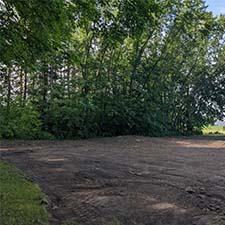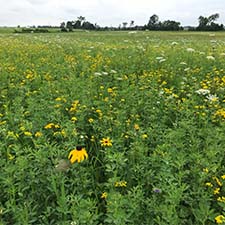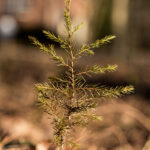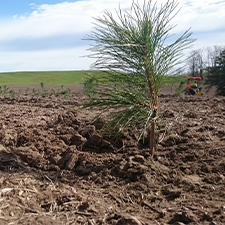Healthy Land Award
The Healthy Land award celebrates improvement projects that help to support and protect natural heritage features including woodlands, wetlands and their functions; wildlife habitat; biodiversity and ecological restoration; soil erosion; and trail development.
The Healthy Land award was presented to the following recipients in 2023:

Bruce Gooch (Township of Oro-Medonte)
In early 2022, Bruce Gooch transformed a quarter acre of his lawn into a meadow habitat to support pollinators and birds in response to the lack of habitat in the surrounding farmland. He planted native seeds, and although it’s a gradual process, promising signs of diverse plant species are already emerging.

Christine Halbot (City of Kawartha Lakes)
Christine Halbot has made a substantial environmental impact by planting cover crops, restoring retired farmland to native meadow habitat, and leading a large tree-planting effort of more than 12,000 native trees and shrubs on her property. Her actions will not only enhance the landscape’s beauty, but will support biodiversity and contribute significantly to carbon sequestration, reducing greenhouse gas emissions for climate stability.

Craig Hayhoe (Township of King)
Since 2008, Craig Hayhoe has collaborated with the Conservation Authority on multiple tree planting projects on his property. These efforts spanned over the last fifteen years and enriched 6.50 acres with nearly 5,200 species comprised of White Pine, Norway Spruce, White Spruce, Eastern White Cedar, Silver Maple and Green Ash trees. Despite challenging soil conditions, the trees have thrived and grown remarkably well.

Don Chapman Farms (Town of East Gwillimbury)
Don Chapman Farms cultivates more than 2,000 acres in the Holland Marsh. In 2022, they worked with the Conservation Authority to plant cover crops on 52 acres of their property for soil protection. In May 2023, they planted 38 acres with cover crops to protect their land from soil erosion, weeds, and wind damage. Additionally, they also operate Lakeview Vegetable Processing, where in 2019 they installed a state-of-the-art wash water treatment system to reduce water consumption and minimize discharge and nutrient outputs during the vegetable washing process.

John & Jackie Sowerby (Township of King)
In 2021, John and Jackie Sowerby began a tree-planting project on their property, which required significant preparation. They removed old fencing, prevented weed growth and worked with a local farmer to prepare the land. In May of 2023, they successfully planted a total of 3,300 tree seedlings comprised of White Pine, Red Pine, Norway Spruce, White Spruce, Eastern White Cedar, European Larch, Red Oak and Bur Oak on 1.66 hectares of land. Their dedication to environmental stewardship is commendable and serves as an inspiring example for others to follow.

Keld & Angela Greflund (Township of Brock)
Keld and Angela Greflund planted 2,400 trees on their property, actively promoting a sustainable future. Through their actions, they have contributed to carbon sequestration, reducing greenhouse gas emissions, mitigating the effects of climate change and supporting biodiversity and a healthier ecosystem by enhancing the natural balance in the area.

Trevor Beatty (Township of Brock)
Trevor Beatty of Riverside Farms Ltd. partnered with the Conservation Authority for three years to plant cover crops on 35 acres of his farm. Cover crops improve soil health, prevent soil erosion, enhance water filtration and promote beneficial soil microbes. The root systems of cover crops act as protective shields, preventing the soil from being washed away by heavy rainfall or carried off by strong winds.
![]() Who to Contact
Who to Contact
Katarina Zeppieri
✆ 905-895-1281 x 116
✆ 1-800-465-0437 Toll free
✉ k.zeppieri@lsrca.on.ca
![]() Award nominations
Award nominations
Thank you for submitting your 2023 award nominations. Nominations are now closed.
